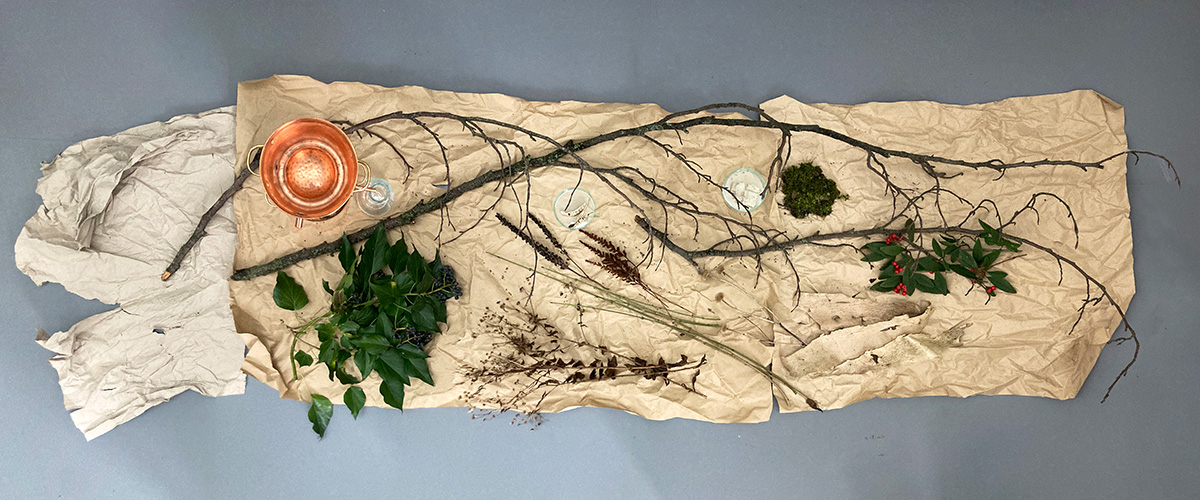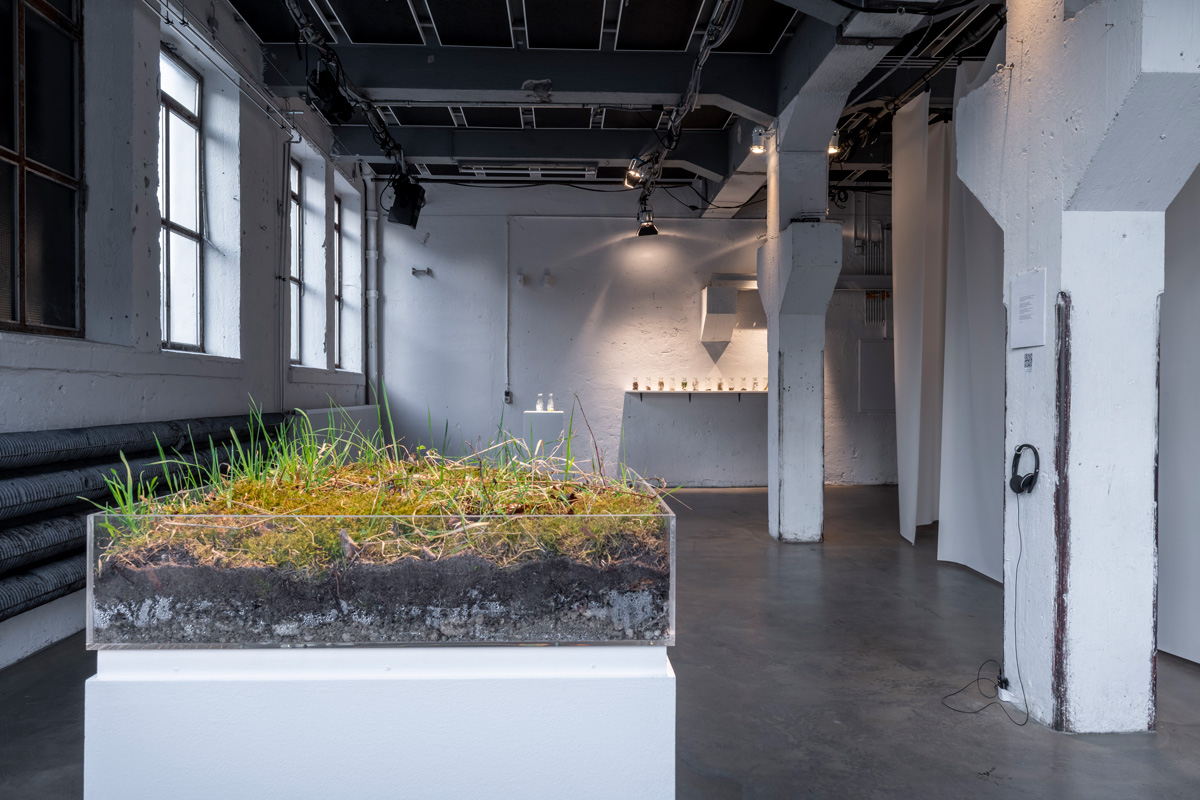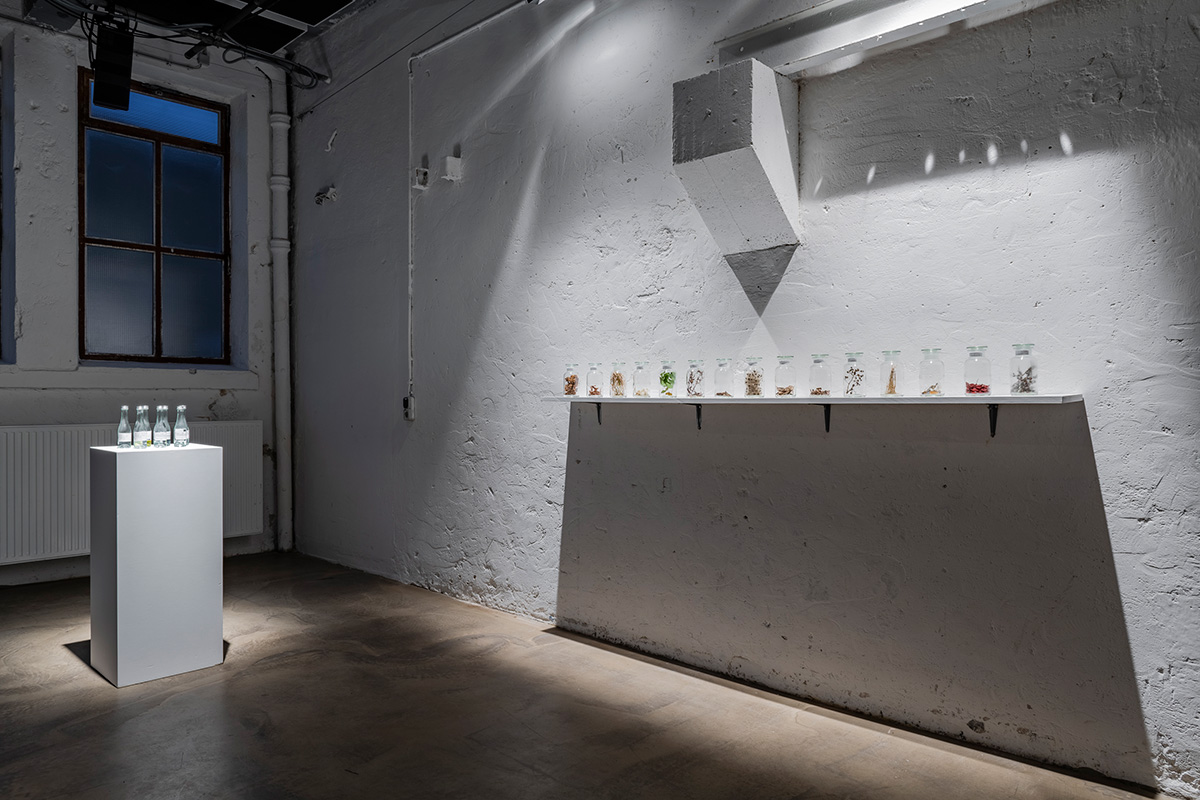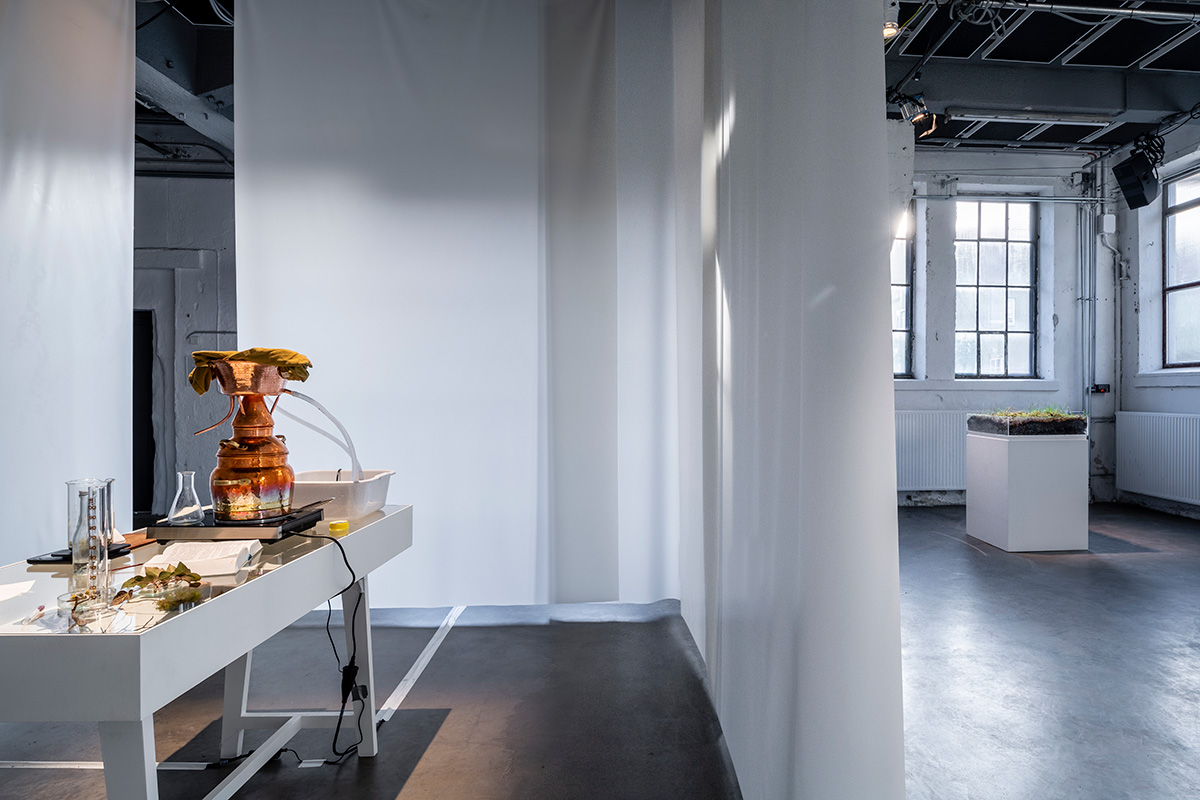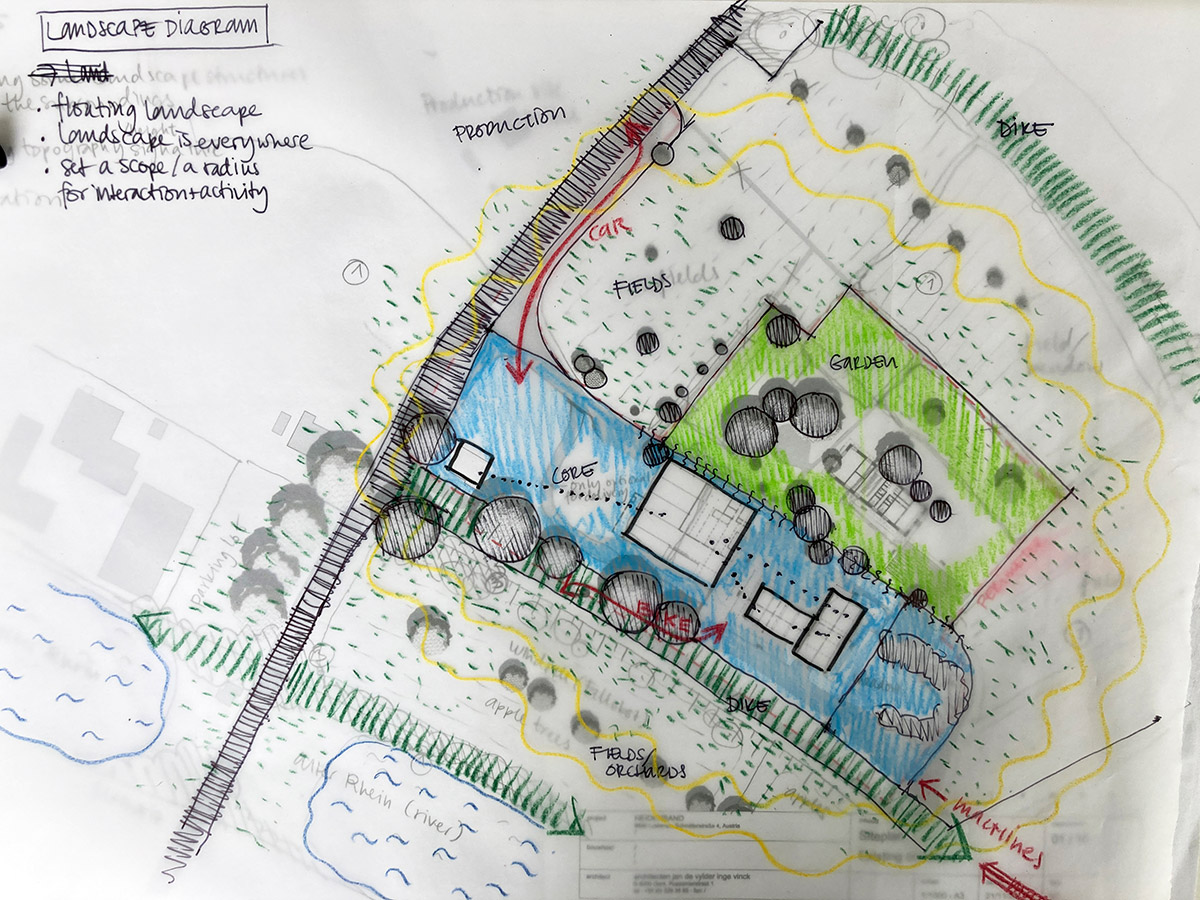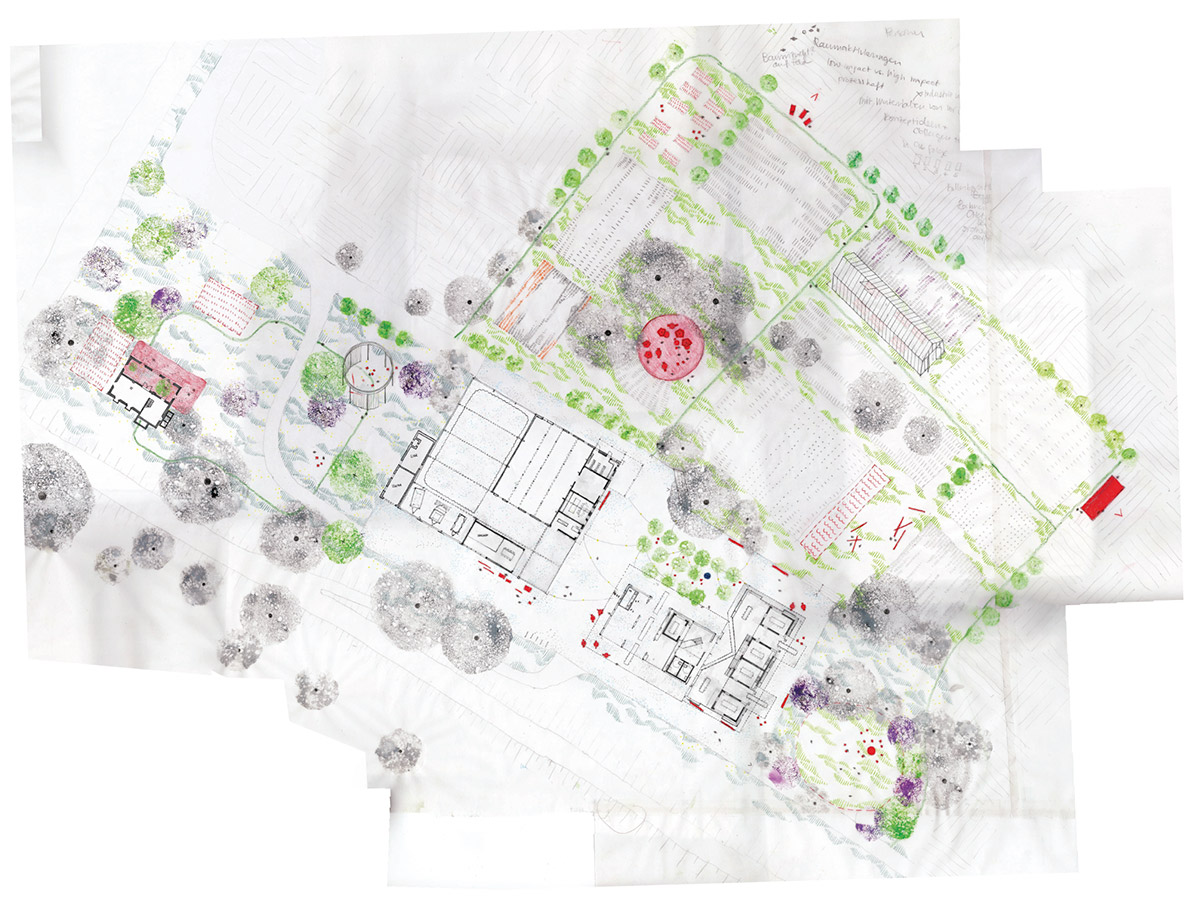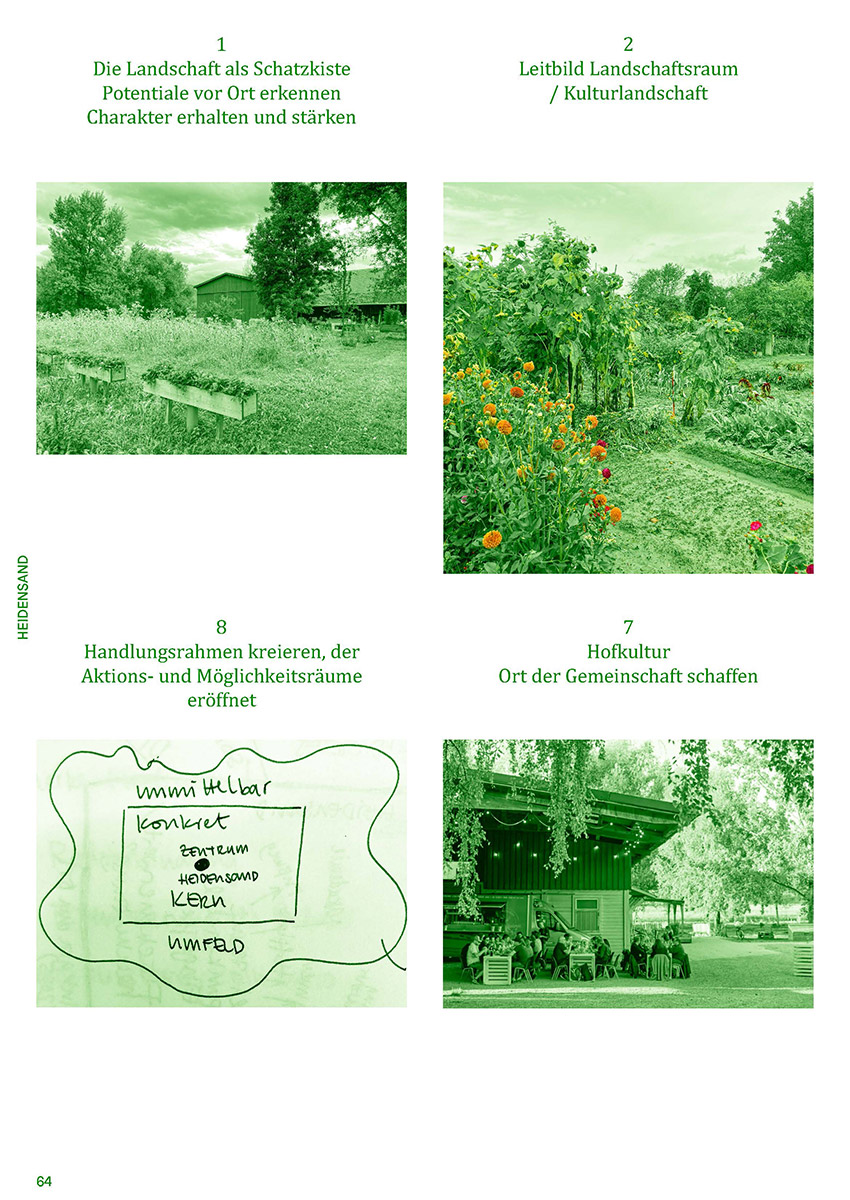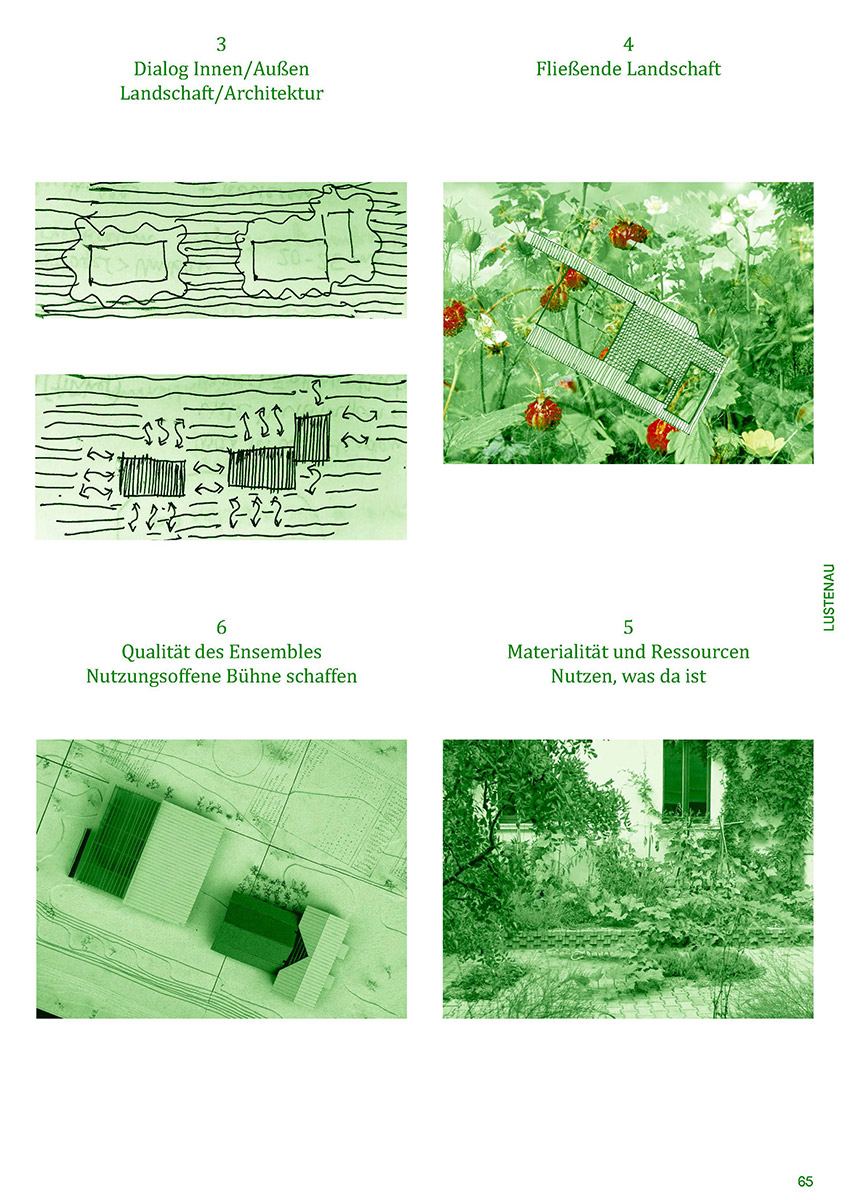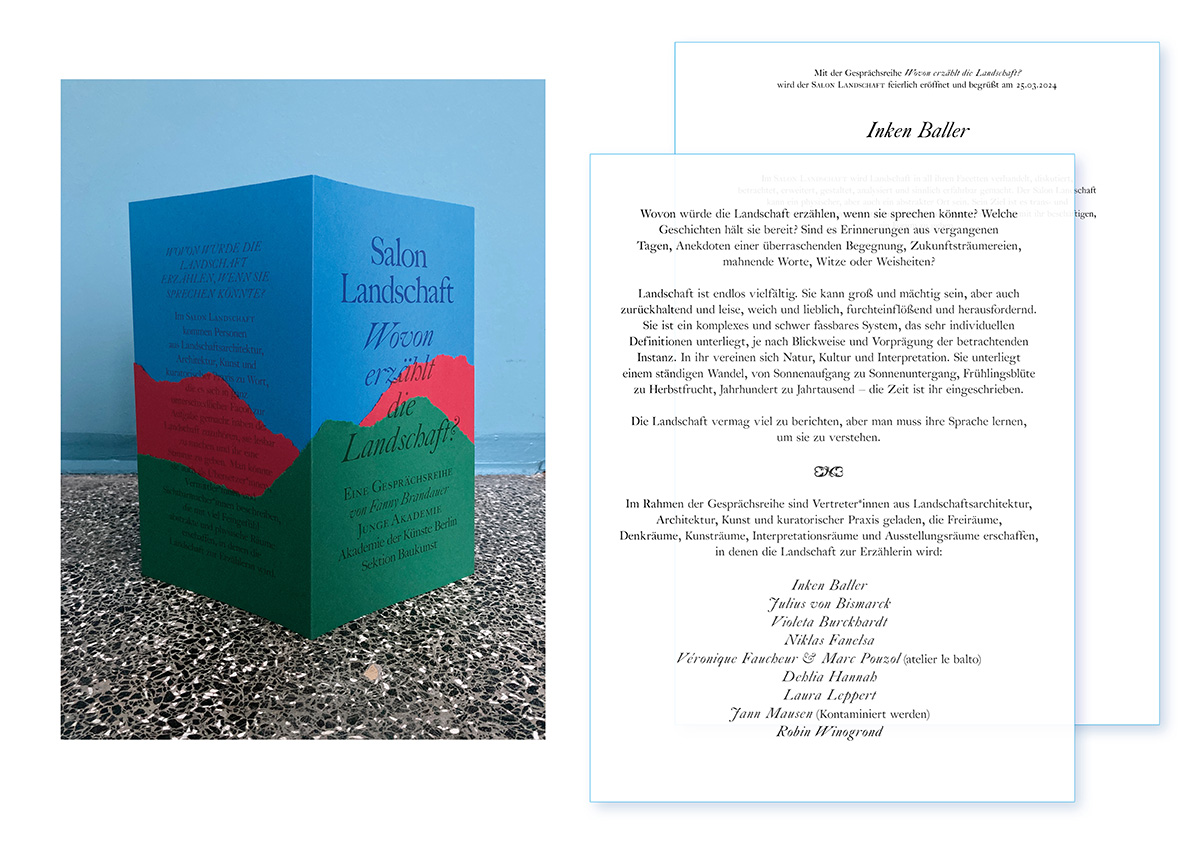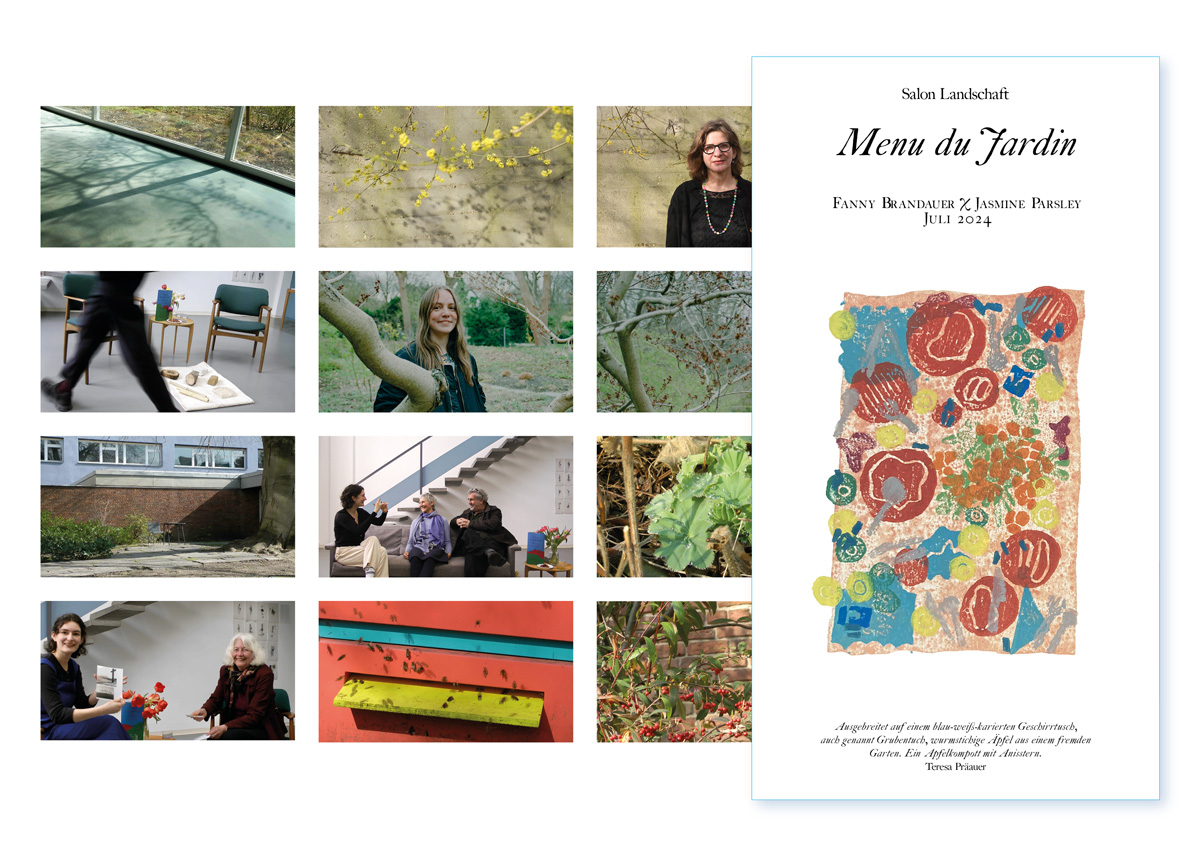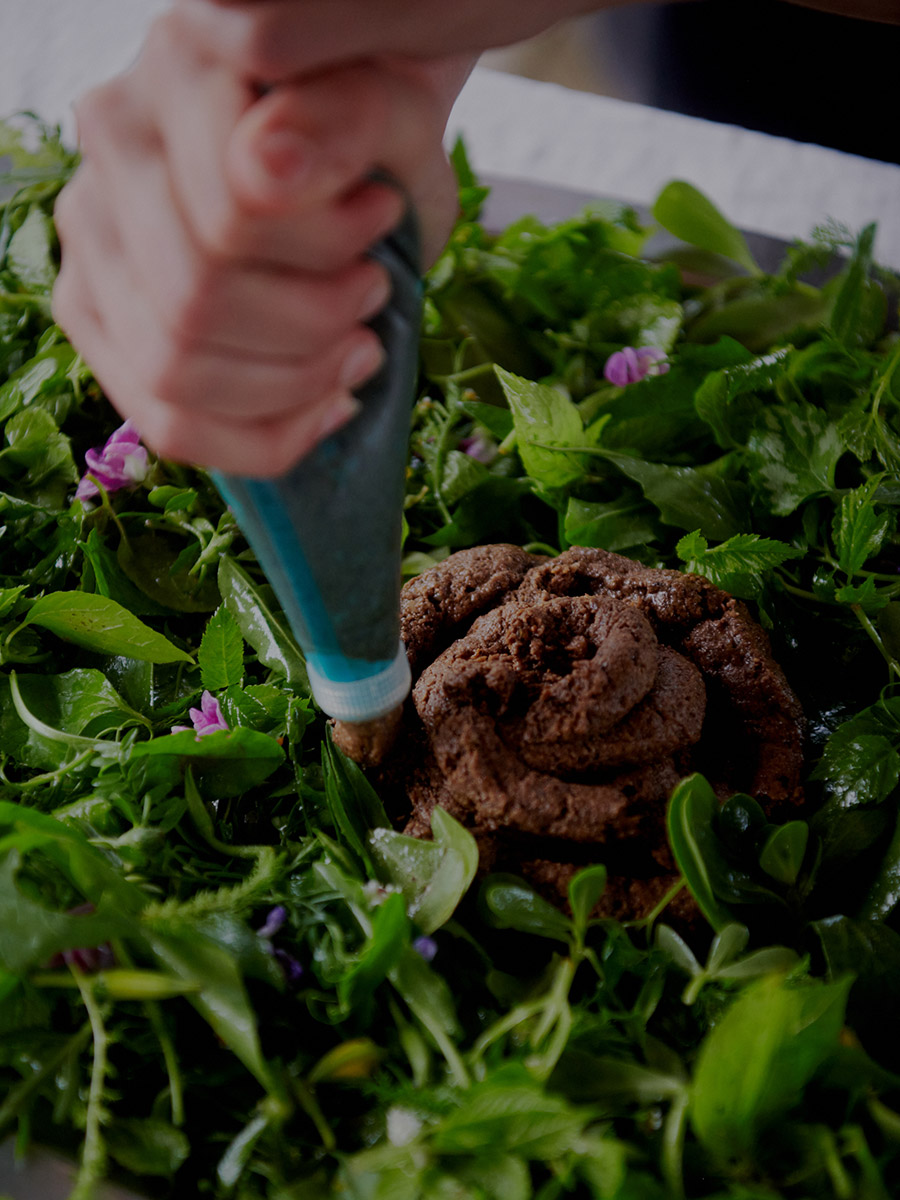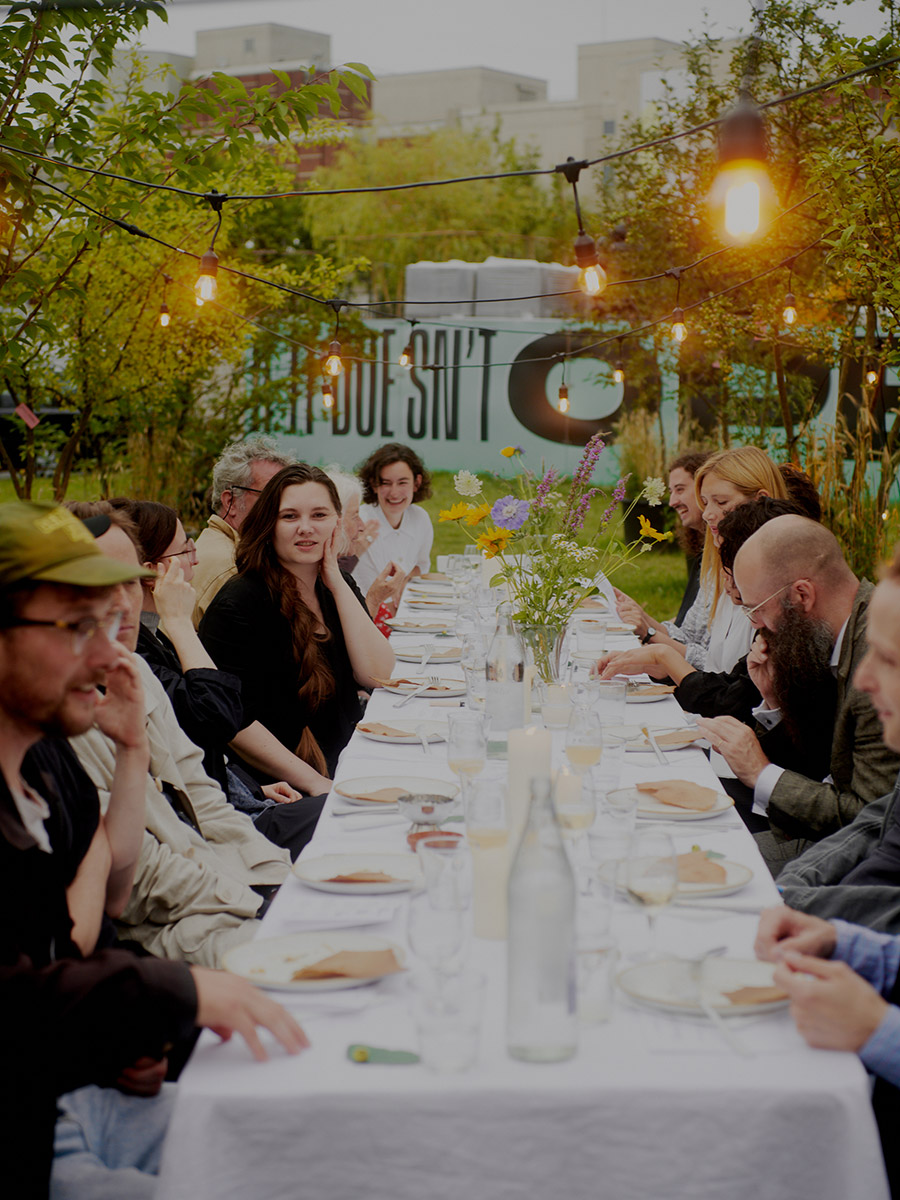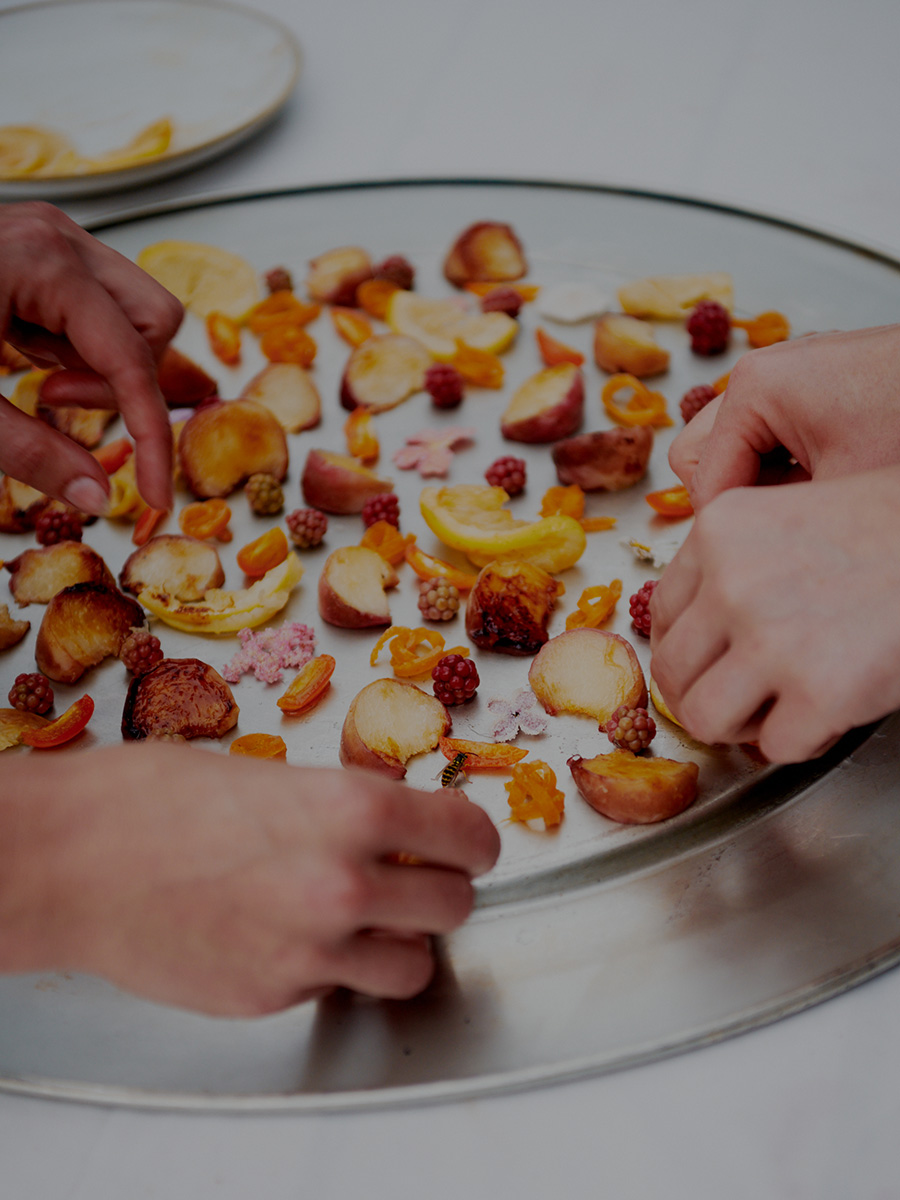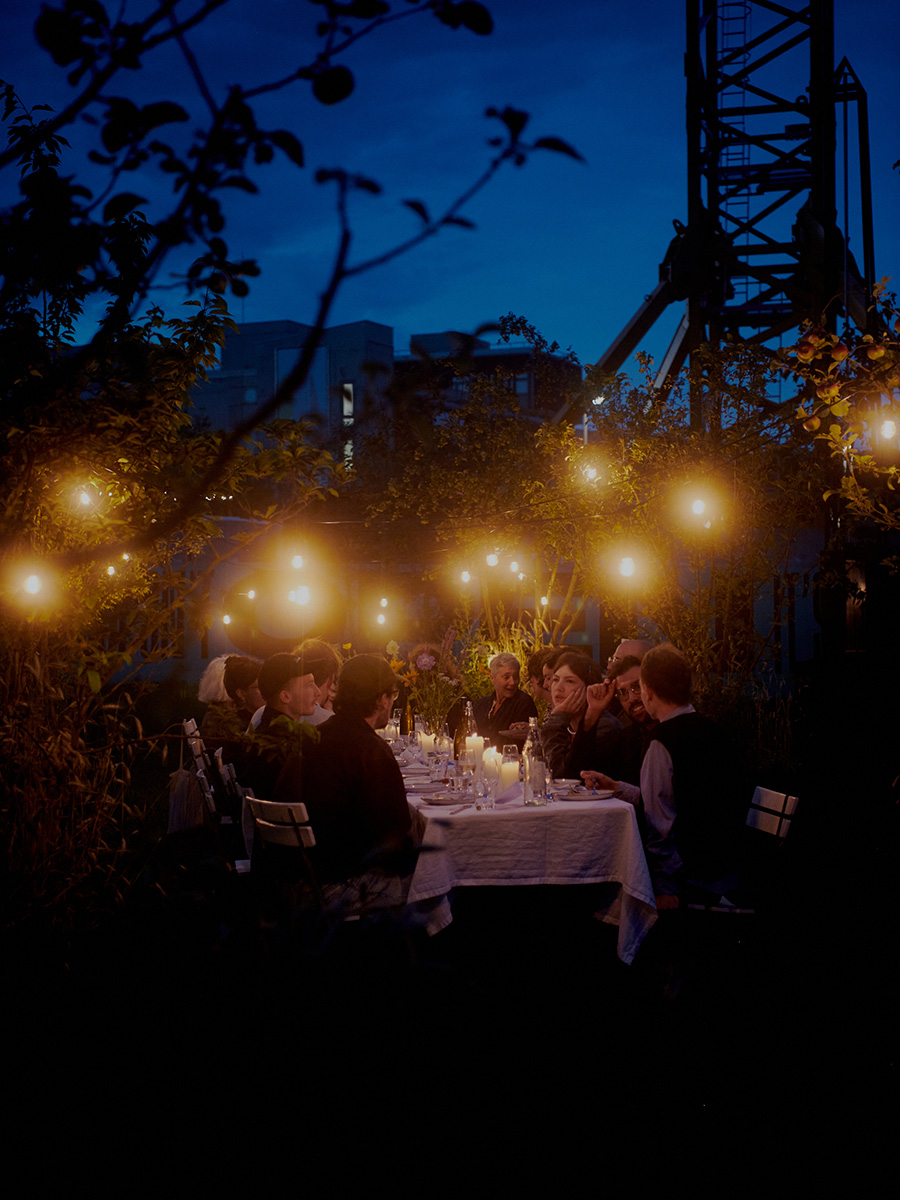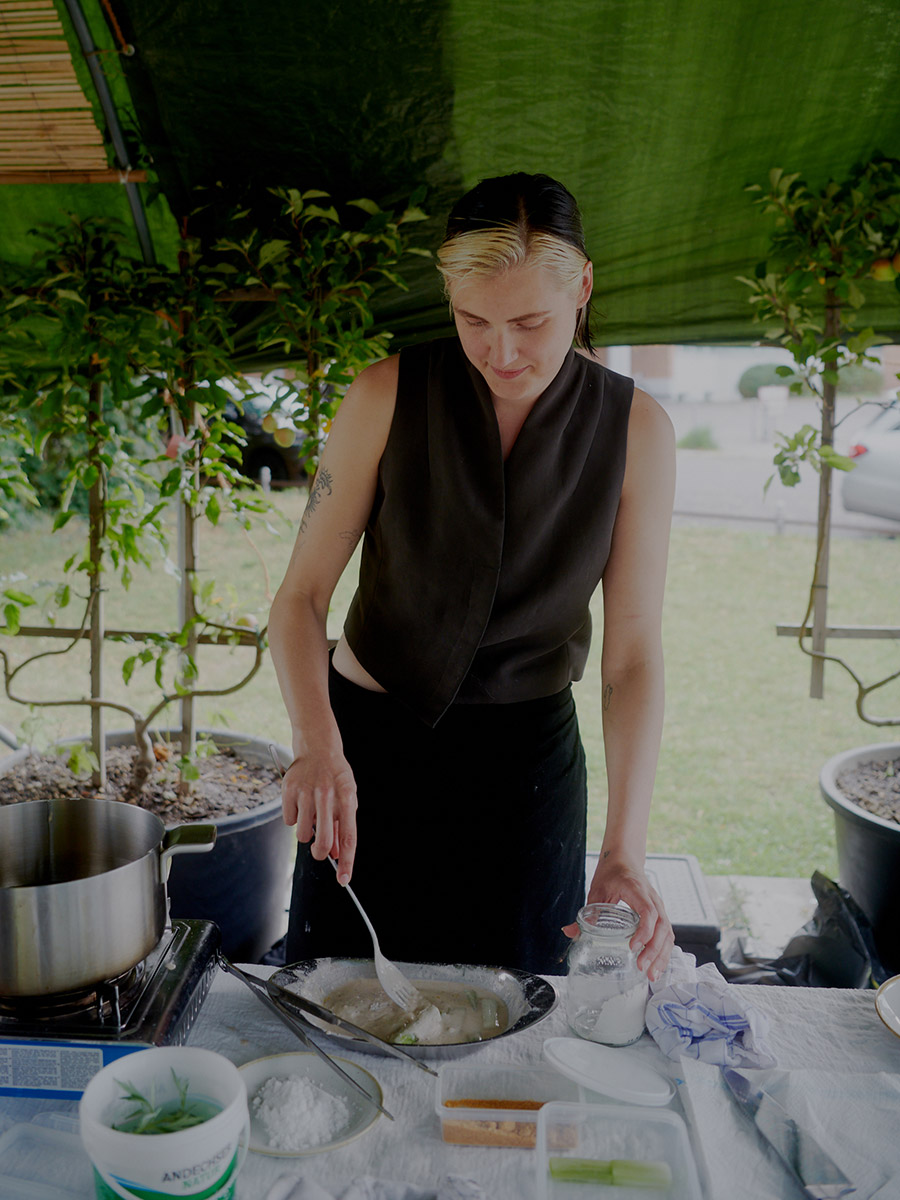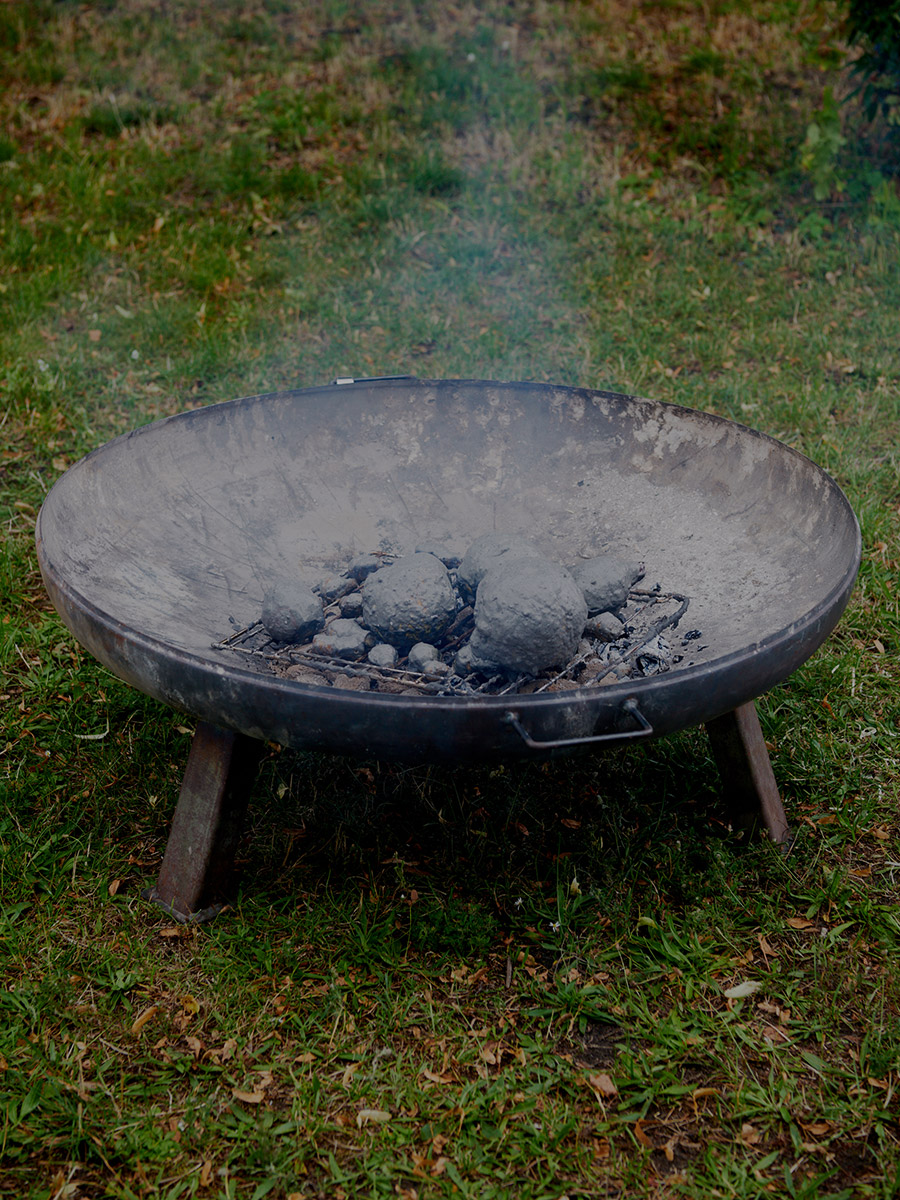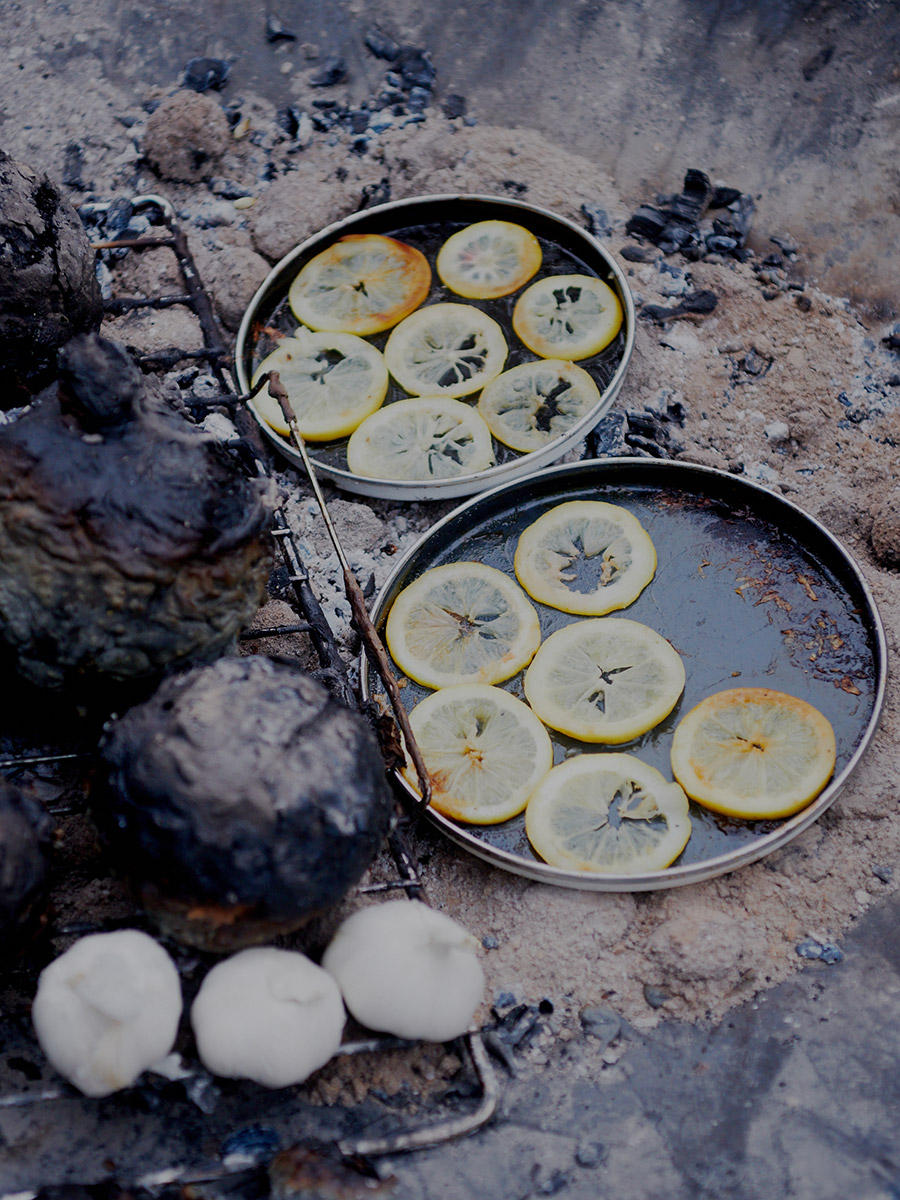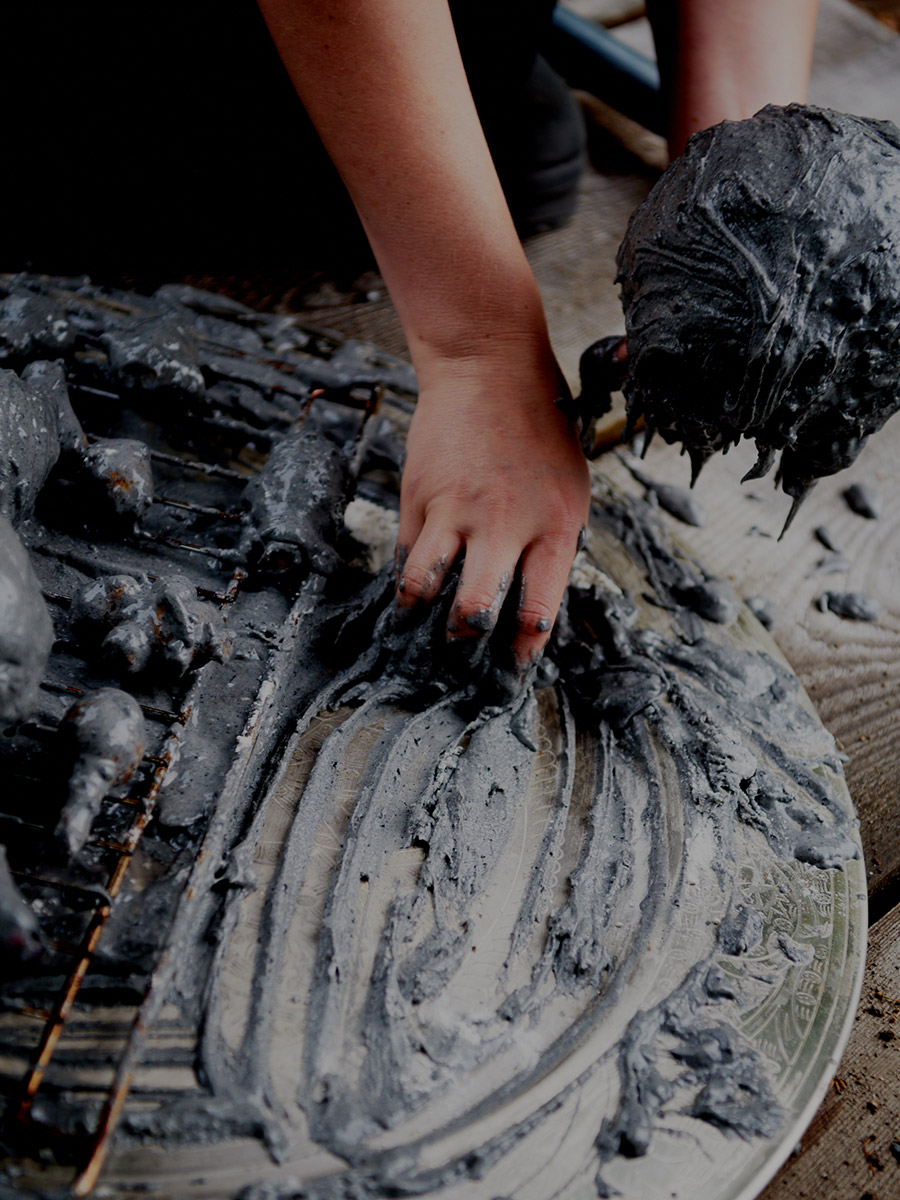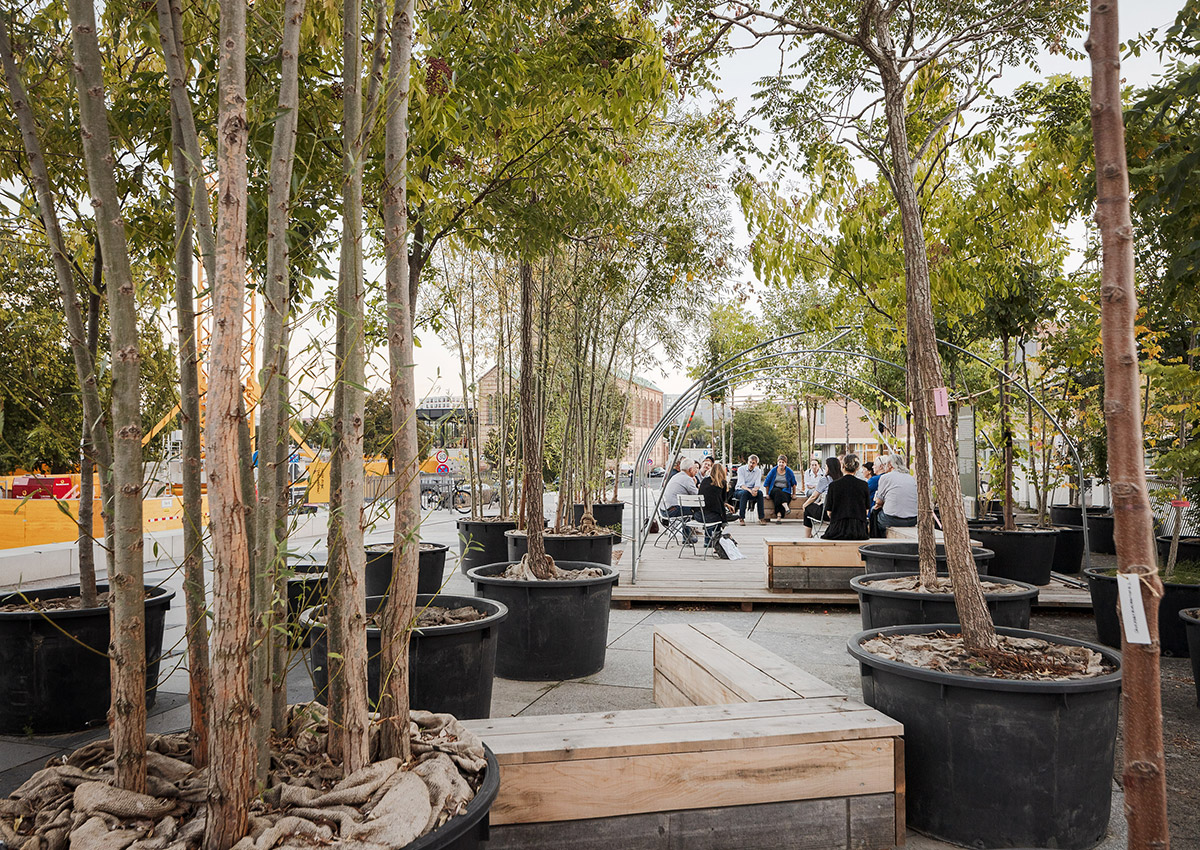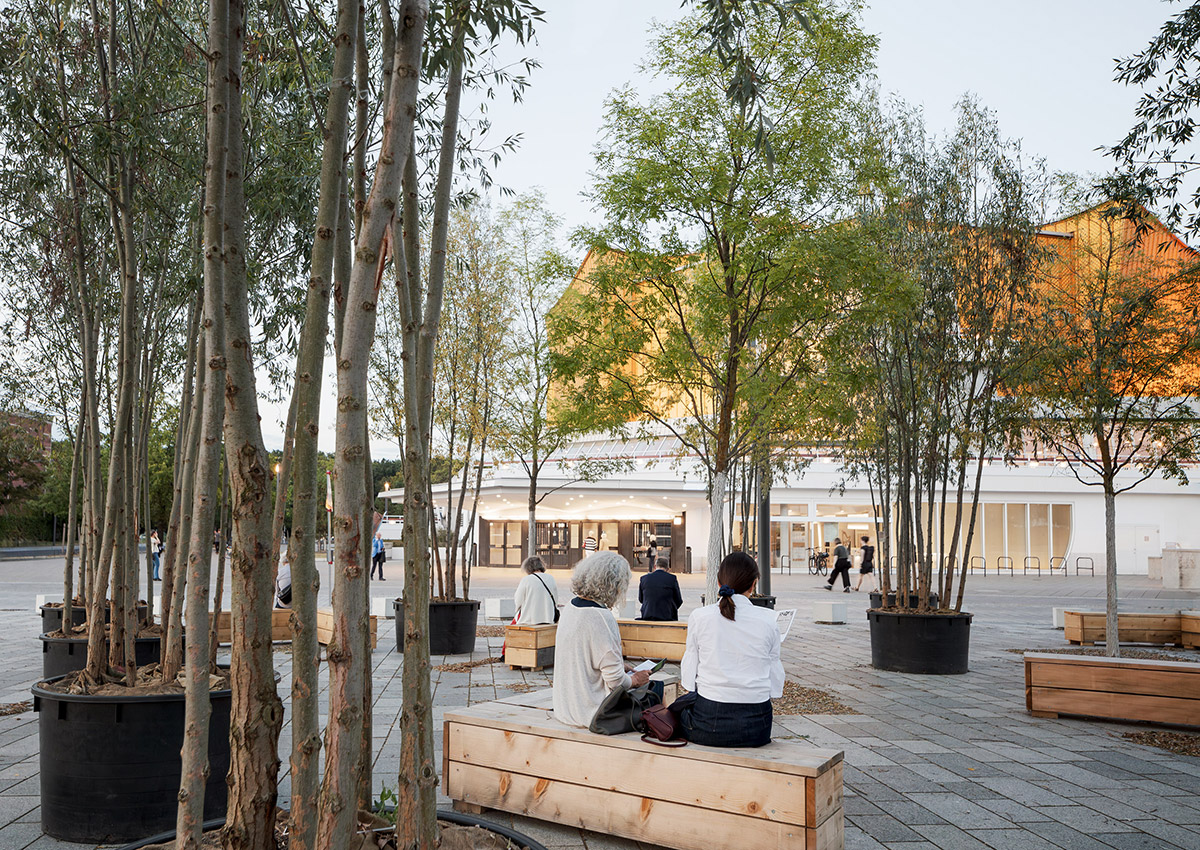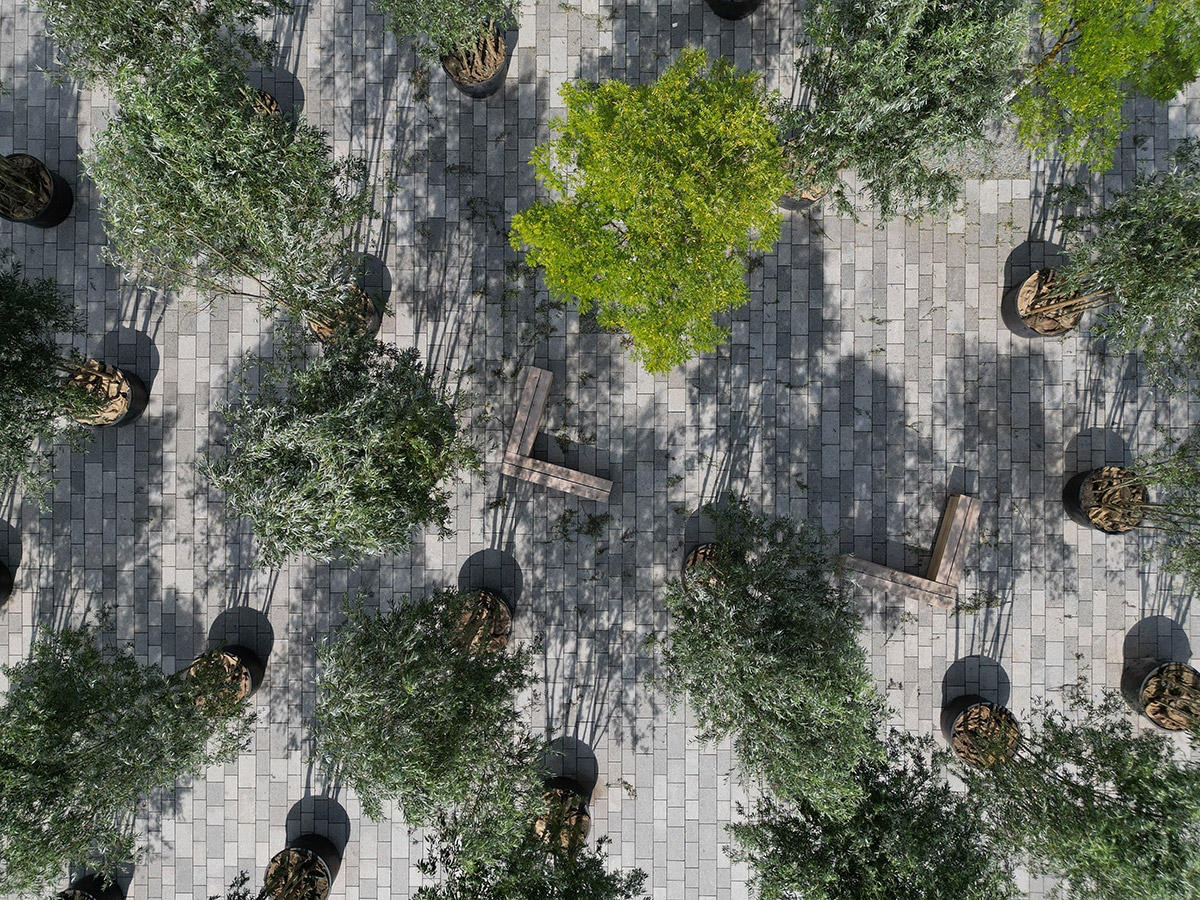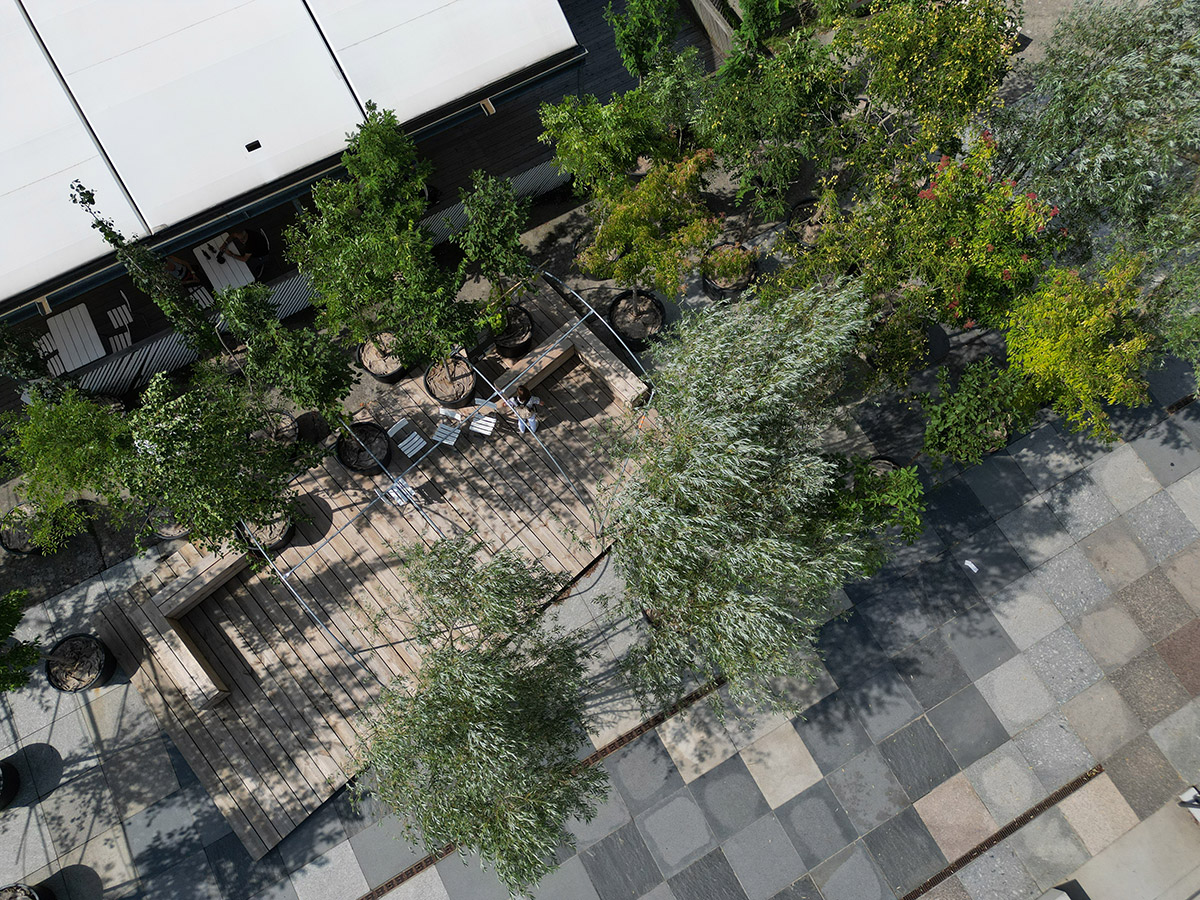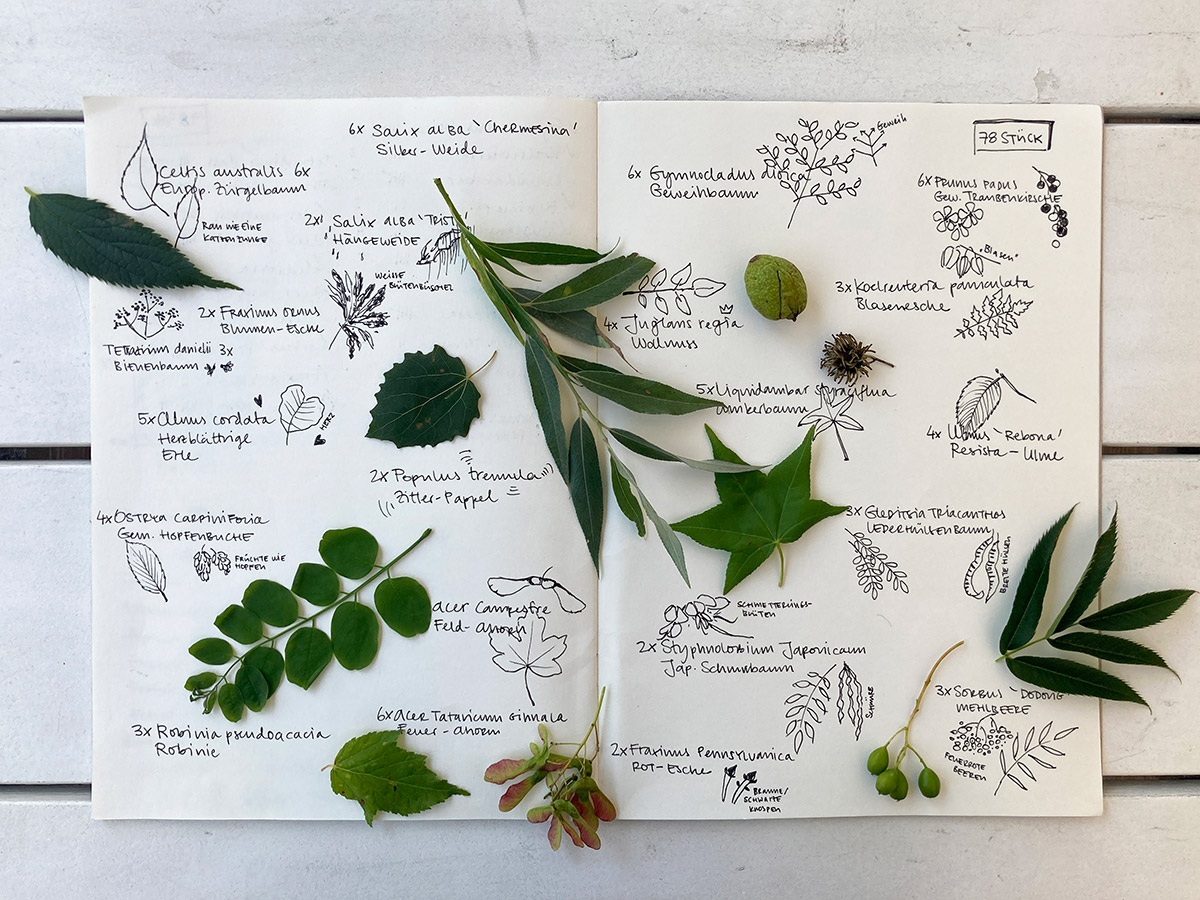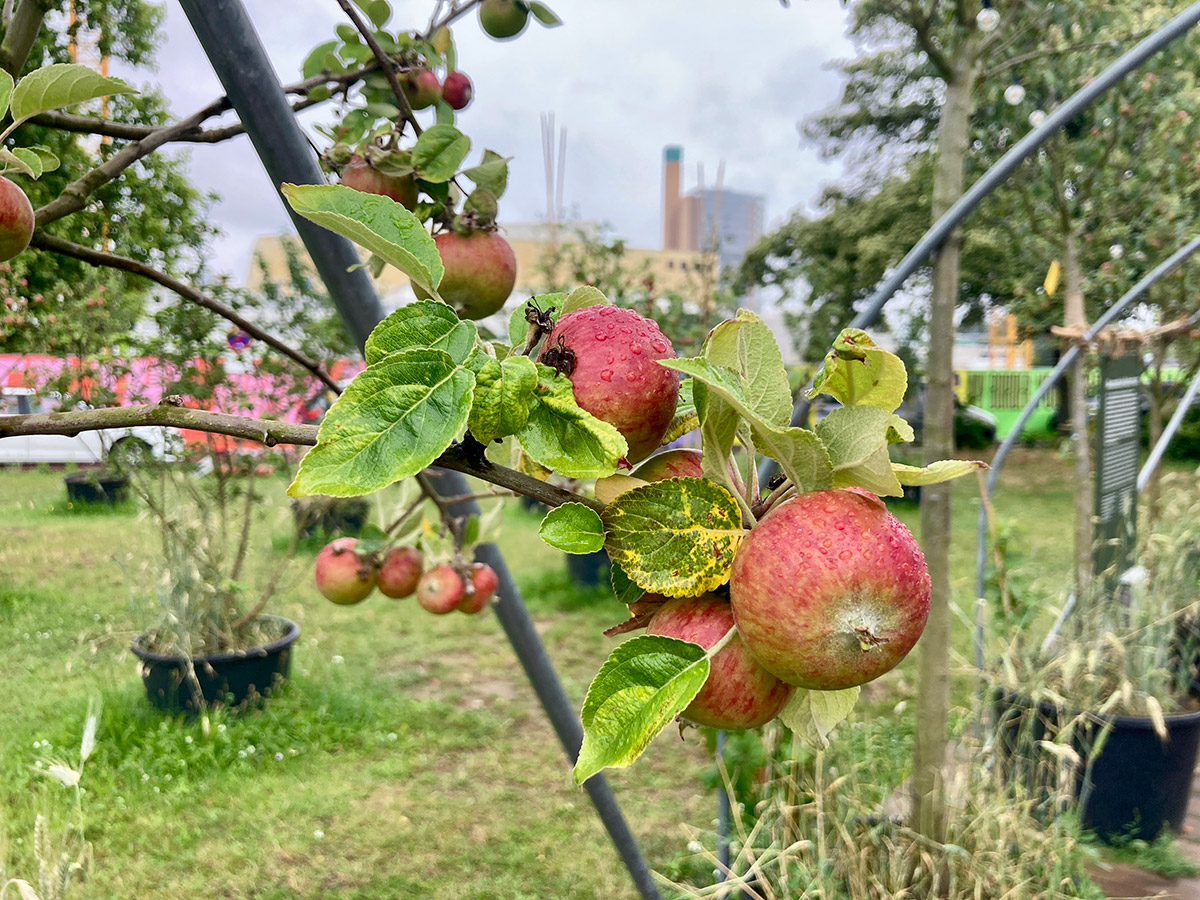24/009
Fanny Brandauer
Landscape Architect
Berlin/Munich/Vienna
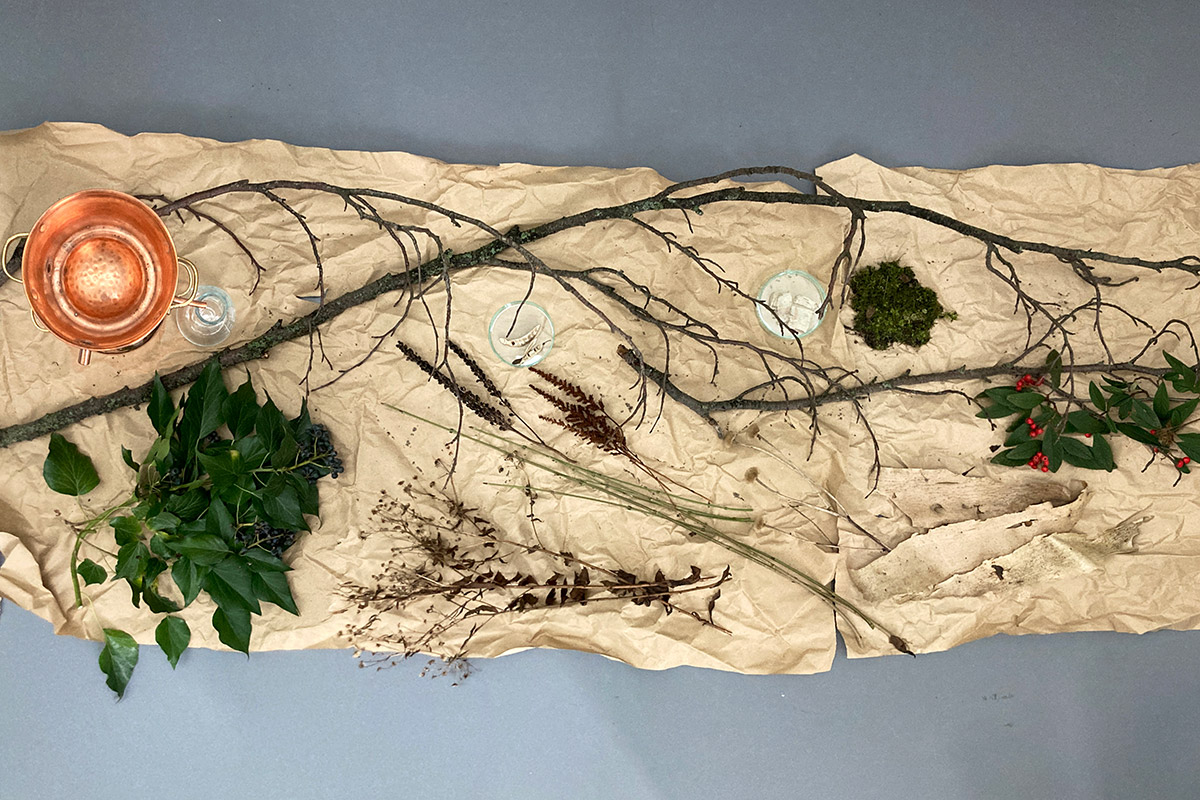
«My aim is to open up art and cultural spaces for landscape architects.»
«My aim is to open up art and cultural spaces for landscape architects.»
«My aim is to open up art and cultural spaces for landscape architects.»
«My aim is to open up art and cultural spaces for landscape architects.»
«My aim is to open up art and cultural spaces for landscape architects.»
Please, introduce yourself and your studio…
My name is Fanny Brandauer, I am a landscape architect based in Berlin, Munich and Vienna. My work is characterized by its cross-disciplinary approach, bridging landscape architecture, curatorial practice and visual arts. Before founding my own studio in 2023, I have been working for a landscape architectural office in the position of team and project leader for several years.
I explore and reflect on how landscape can be perceived, represented, conveyed and made visible within (interior) exhibition spaces as well as in art and cultural contexts. Within that scope I create artistic formats and networks that focus on landscape, nature/culture, spaces and environments. A collaborative character is key in my practice. I actively seek exchange with individuals from diverse professional backgrounds to create new synergies and provide a platform for landscape on many levels. In addition to design projects and installation works in indoor and outdoor spaces, I am also involved in teaching.

Portrait Fanny Brandauer – © Nora Hollstein
What is the essence of landscape architecture for you personally?
For me personally, it is about learning to read landscape and developing a profound understanding of it. This is a process that requires a great deal of experience and takes many years. I have only just begun this journey. It involves understanding landscape as a complex global system influenced by various factors: human and non-human entities, time, interpretation, weather, climate, economic, political, social and ecological interests and parameters – just to name a few. When working with landscape, it’s necessary to decoat these layers and understand broader contexts.
Our craft is to change, shape and design spaces – which gives us a certain form of power. Every action we take means a transformation of environment. Therefore, I see it as the duty of every landscape architect to handle this privilege with utmost responsibility and care. Often less is more. If we do our job well, we are in the incredible position to create living spaces and spatial atmospheres. I see ourselves not only as designers but also strongly as communicators who can give landscape a voice – or rather let it keep its own voice but make it audible for an audience.
How did you find your way into the field of landscape architecture?
Besides others it was my grandmother, who had a profound influence on me. She was well-versed in botany and ornithology and would take me to the woods and up the mountains, teaching me how to collect, identify, dry and catalog plants. Looking back, I anchor my first conscious encounter with landscape during these times. During high school, I developed an interest in art history and architecture. Combining all these interests and stirring them together ultimately led me to landscape architecture.
I completed my bachelor’s degree at the University of Natural Resources and Life Sciences (BOKU) in Vienna and my master’s at the Technical University of Munich. Already then the interrelation between landscape and art particularly fascinated me and most of my academic projects explored this interface in some way. This focus culminated in my master's thesis "Exhibiting Landscape: Transferring Landscape into the Interior Space“, which now forms the theoretical foundation for my self-employment.
Rossows Garten, Open Studio, 2024, Akademie der Künste Berlin – © Fanny Brandauer
Landscape in the interior space? How is this accomplished and makes it particularly intriguing to you?
The Swiss landscape architect Dieter Kienast was one of the first in his field to explore and experiment with exhibitions and installations as a way of showing and conveying landscape – moving beyond the conventional visual forms of plans, models and drawings, which often require some degree of professional expertise (e.g. reading a plan). To this day, only very few landscape architects use it as integral part of their practice.
The challenge, of course, is: how does one exhibit space within space? And subsequently: how does one exhibit an outdoor environment within an interior space? In European art history, artists have been dealing with the representation and visual interpretation of landscape already since the movement of landscape painting in the 17th century. However, this is not the case with landscape architecture, even though it deals with landscape on a daily basis. And this is where my work begins.
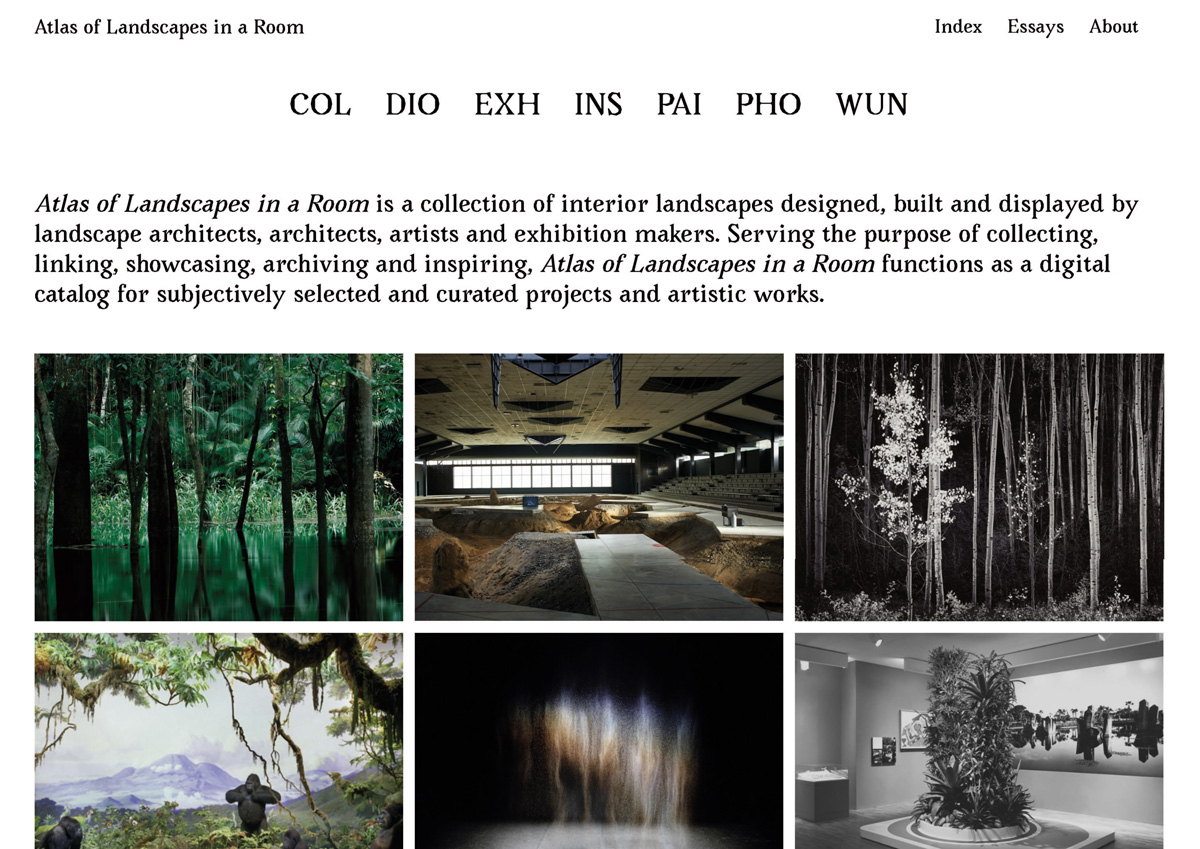
Atlas of Landscapes in a Room, since 2021 – © Fanny Brandauer
Transferring landscape into the interior space means a process of removing, isolating and recontectualizing landscape or fragments of it. What happens is that the focus of perception and observation shifts and sharpens. The enclosed indoor space (the „box“) offers one opportunity to deconstruct this hyper-complex and multi-layered landscape system and to delve very specifically into individual scales, aspects and contents. These can be diverse, including ephemeral elements such as scent, sound, temperature, movement or time. Physical experiences and memories are created. Particularly interesting is the question of how these new experiences can then be transferred back to the external landscape, spatially as well as mentally. Here the architecture should not be seen as barrier rather than a permeable transition zone. There is a constant flux between interior and exterior.
My aim is to open up art and cultural spaces for landscape architects. I critically question why landscape architects continue to only occasionally act as curators, designers or co-creators in such contexts. For instance, at the Venice Biennale of Architecture, landscape architects are scarcely present, even though the recent professional discourse would have long since demanded it.
What are your experiences founding your own studio and being self-employed?
After graduating from university I worked in an office for landscape architecture for several years. The decision to become self-employed was driven by several factors, but primarily by the deep desire to re-engage with certain questions I had addressed with my master’s thesis. In 2022, I quit my job and allowed myself a six-months break to clear my mind and recharge my batteries. I didn't start my self-employment with a specific project but rather with a vision. Looking back, I realize how crucial this break was in order to let this certain vision slowly grow and mature.
In my self-employment, I have quite moved away from the „traditional“ field of landscape architecture. At the same time I had to deal with the fact that there was no predefined job description for the things I had in mind. I had to create my own job description and develop it into an independent practice. Besides typical bureaucratic challenges, I find myself confronted with the question of legitimation and identity. I am more and more coming to the conclusion that ultimately I would like to move away from this stereotyped thinking in boxes and categories. Yes, I am a landscape architect, but I also maintain an artistic and curatorial practice. It’s not a matter of either or. It’s a hybrid practice!
Despite many challenges and efforts I do not regret my decision in any way. I thoroughly enjoy having the liberty to choose the projects I want to work on and the people I want to collaborate with.
How do you remember your time as landscape architectural employee?
My time as an employee was crucial and has significantly shaped my current work approach. It strengthened my design skills and taught me how to professionally organize and structure projects, confidently interact with planning partners and clients, budget costs and keep complex timelines in perspective. In a secured environment with a safety net, I was able to train my skills and become acquainted with diverse tasks at various scales.
During my employment, I managed a very high workload. Many of my projects and tasks required overtime (which was always compensated!). My workload in self-employment has probably remained similarly high, but with the difference that I can manage my own hours. This, however, results in an increasing blur between work and private life, with my mind constantly at work – I am trying to change that; it’s a process.
In self-employment, of course, responsibilities change. Justifying decisions and being held accountable for potential mistakes is part of the deal. However, to me it offers a far more experimental and fulfilling working style compared to employment, where one ultimately commits to the design language and philosophy of an employer. At the moment I am working „solo“ in collaborations with different partners at eye-level, so I am not holding any responsibilities for employees, but who knows what the future brings.
What are you working on at the moment?
I work on a diverse range of projects at various scales, from landscape architectural design tasks to exhibition projects, artistic formats as well as lectures and teaching. A significant portion of my time is also dedicated to writing project proposals and grant applications. Currently I am developing "Salon Landschaft", which is an artistic-landscape architectural format where landscape is communicated, negotiated and made visible, providing a forum for the landscape itself and those who engage with it.
What does your desk/working space/office look like at the moment?
From January to March 2024, I was a fellow at the Academy of Arts in Berlin, where I had the privilege of working in a wonderful studio designed by Werner Düttmann in 1960. These premises truly inspired me. I personally experienced the profound impact well-designed architectural space can have on creative work. During the past few months I was subletting the beautiful studio of Berlin-based artist Jeewi Lee, located in an old glass factory in Kreuzberg – but planning on opening my very own studio space by the end of the year.
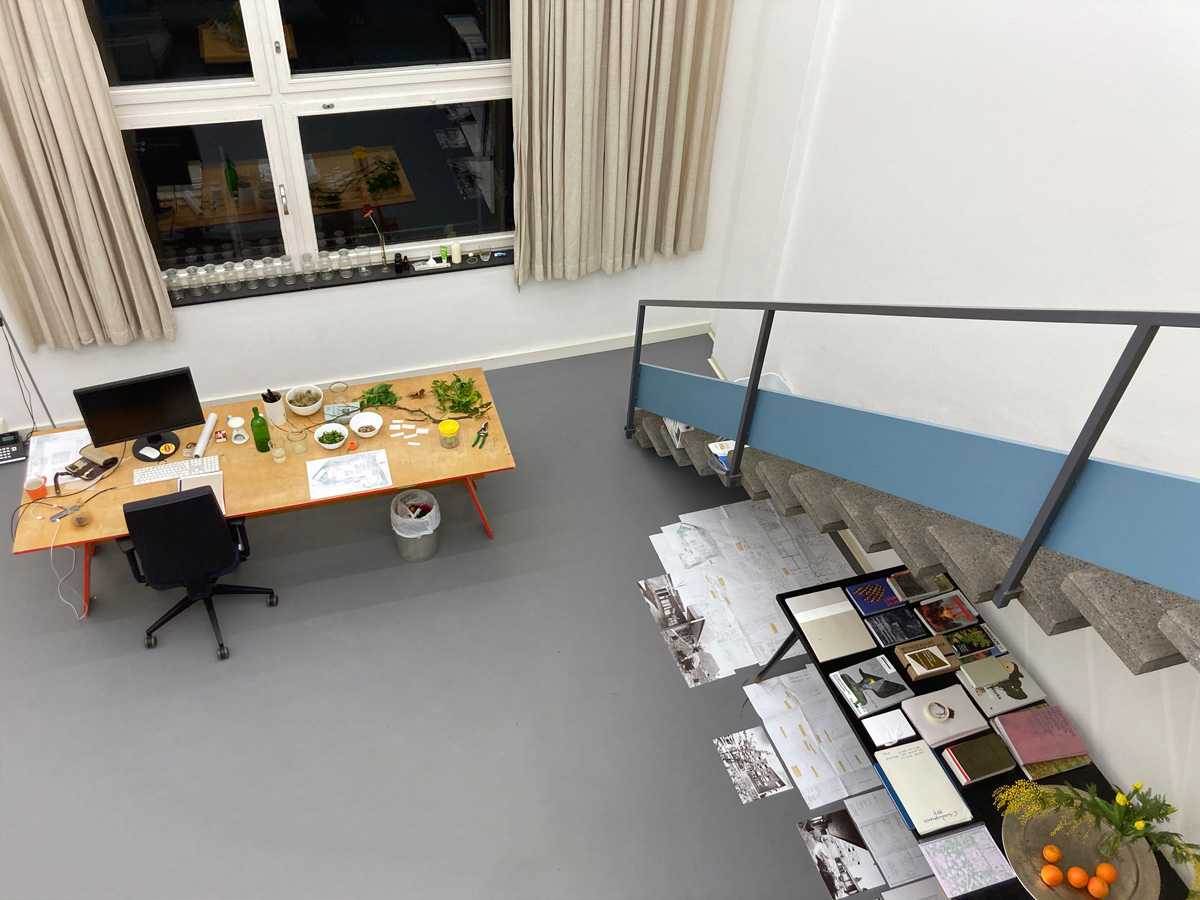
Atelier AdK – © Fanny Brandauer
What is your favourite tool to design/create landscape architecture and why?
The body. Landscape must be sensually perceived before one can truly work with it. Of course studying the history, geology, vegetation, usage, etc. of a site is also essential. Everything that follows is a matter of (media) translation. This can be a sketch, a story, a CAD drawing, an exhibition, a model, an intervention, a film or something completely different. Ideally, the translation tool is chosen to suit the narrative.
Name your favorite…
Garden: Insel Hombroich
This place enchanted me like only few others have. Insel Hombroich is not an island surrounded by water, but rather an island in the sense of a special biotope, where this incredible synergy between landscape, architecture and art has been created. I was so captivated and moved by this place that it made me cry. I still often think about it today
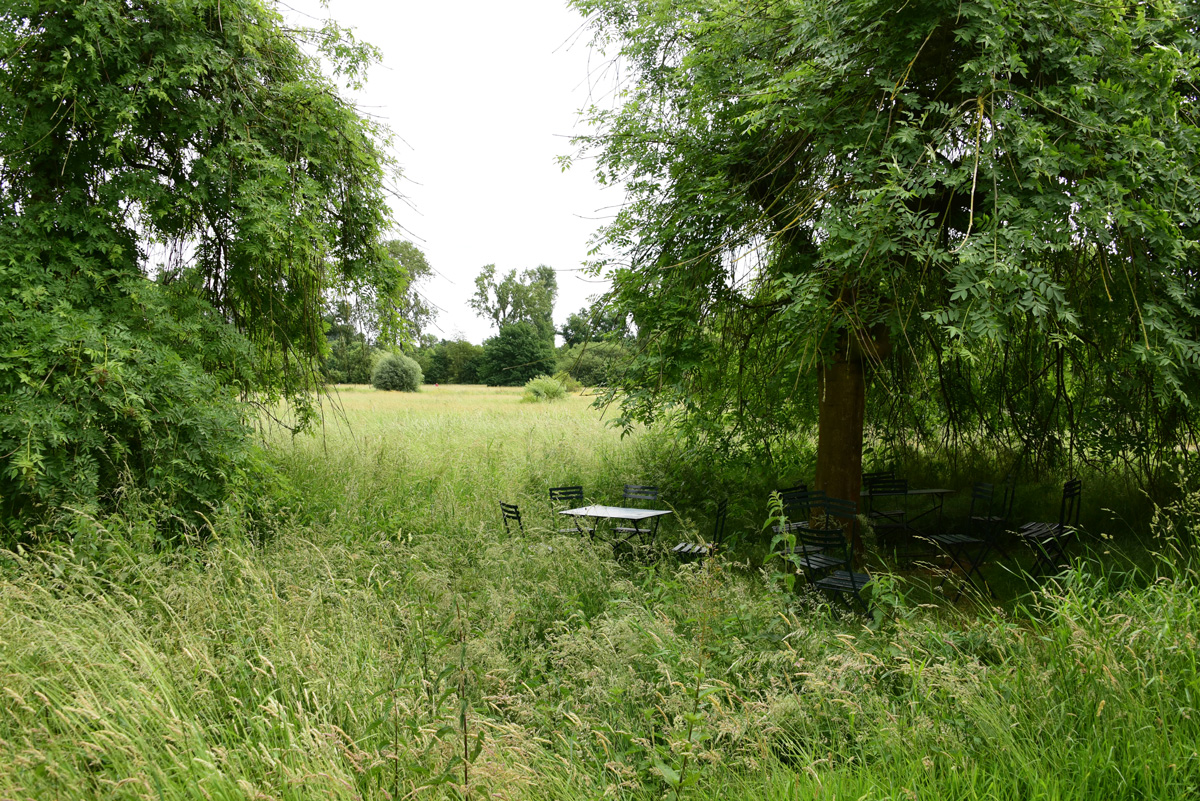
Insel Hombroich – © Christoph Helfrich
What needs to change in the field of landscape architecture according to you?
I believe that the self-perception and attitude of landscape architects needs to evolve. The profession, as it is understood today, is relatively young and currently in the process of emancipating itself from architecture. Landscape and architecture can and must be thought of as a unit—after all, the house sits in the landscape, not the other way around. For this to be effective, the exchange between landscape architects and architects needs to stand at the beginning of a project, not at the end, and it should be a collaboration of equals, not a hierarchical relationship. This must already be trained intensively in schools and universities to later become a natural part of project work. It should be seen not as a challenge, but as an opportunity.
In my view, the development of a strong self-understanding also includes engaging in theoretical and critical discourse within the discipline (e.g. in daily office life), which I often find severely lacking. I can see that this is slowly changing, but there are still only a handful of landscape architectural journals, panels, discussion series or other exchange formats that focus not just on lectures and information, but on conversation and discussion. However, it’s not only the internal professional exchange that should be strengthened. I also find it intriguing to consider how landscape architecture relates to other fields of profession such as art, philosophy, history, sociology, urban ecology, etc., and what roles these can play within landscape architecture. Landscape incorporates incredibly many aspects. It cannot be thought of in isolation!
Additionally, I wish for more courage and conviction. More courage to think outside the box. And more conviction, strength and clarity in expression and aesthetics. In my opinion, many landscape architects still hide in the vague loveliness of "beautiful green" plans – or make themselves comfortable within them – I sometimes find myself in it as well, catching myself remaining superficial where depth is required. This is dangerous because landscape architecture will, and already does face significant and challenging planning tasks, demanding explicit and high-quality solutions.
If there were one skill you could recommend to a young landscape architect to study in depth at architecture school: what would it be and why?
There are two key aspects: the willingness to experiment and a collaborative mindset in thinking and working. During architecture school, you are in the incredibly privileged position of being able to build „castles in the air“.This means having the freedom to try things out, spin ideas, research, make mistakes, be radical, dig where it hurts and then dig deeper and discover what truly interests you. You begin to develop a stance, which can certainly change over the course of a career, but in my opinion, it takes root already during your studies. Keeping an eye on reality is important, though it catches up with you in professional life faster than you might think. Practicing early on to work in a (transdisciplinary) team (and it is by no means always easy) is very worthwhile. After all, we are always stronger together than alone!
Project 1
Salon Landschaft
since 2024
Earlier this year I founded Salon Landschaft, which is an artistic-landscape architectural format that explores, negotiates, perceives and discusses landscape and makes it visible in all its facets. Drawing inspiration from the concept of the Salon as a space for gathering, conversation and exchange, Salon Landschaft aims to create an inter- and cross-disciplinary platform, providing a forum for the landscape itself and those who engage with it – its human, non-human and more-than-human protagonists. Landscape oscillates between artificiality and naturalness, controlled design and wilderness, romance and exploitation, the Anthropocene and Posthumanism.
Salon Landschaft seeks to uncover, contrast and address these interstitial spaces and investigates how landscape can be rethought and re-articulated through various media translations – be it artistic interventions, spatial installations, discussion panels or even a theater production. Salon Landschaft is conceived as a continuously growing collaborative project cosmos, supported by multiple pillars, and „writing different chapters“:
Chapter I was written in March 2024 and consists of the conversation series Wovon erzählt die Landschaft?. The series featured guests from a variety of professional backgrounds who engage with landscape on different levels. I am currently working on editing the collected material and turning it into a publication.
Chapter II was most recently written in July 2024. As the grand finale of the conversation series and in collaboration with the artist Jasmine Parsley, I hosted the landscape-themed dinner performance Menu du Jardin in the orchard of Baumschule Kulturforum. All participants and contributors from the discussion series were gathered around a long table to collectively dine, drink, share stories and exchange insights. The eight-course menu was inspired by the landscape narratives, memories and anecdotes discussed in the interviews and every course was dedicated to one particular conversation partner. From the Wadden Sea to lava stones and Bavarian cow pastures, each dish was crafted to offer culinary representations and edible interpretations of these varied environments.
The event emphasized the site-specific use of plants. The focus was not only on the narrative elements of the landscapes but also on the plants themselves as narrative carriers – many of which were sourced and foraged by Jasmine from Berlin’s urban flora. The menu featured, among other items, fire baked vegetables in salt-ash dough, apples from the Kulturforum, fermented nettles from Berlin’s Tiergarten and pickled spruce tips and blackberries from Rehberge.
Salon Landschaft grows over time. New projects will be announced here:
salonlandschaft.com
Chapter I
Wovon erzählt die Landschaft?, Conversation series,, 2024, Akademie der Künste Berlin – Guests: atelier le balto (Véronique Faucheur & Marc Pouzol), Inken Baller, Julius von Bismarck, Violeta Burckhardt, Niklas Fanelsa, Dehlia Hannah, Laura Leppert, Jann Mausen (kontaminiert werden) and Robin Winogrond.
Chapter II
Menu du Jardin, Landscape-themed dinner performance, 2024, Baumschule Kulturforum Berlin – In collaboration with: Jasmine Parsley – Guests: atelier le balto (Véronique Faucheur & Marc Pouzol), Inken Baller, Julius von Bismarck, Raphael Bruning, Niklas Fanelsa, Marie Graftieaux, Elias Hanzer, Clara Herrmann, Nora Hollstein, Charlotte Klobassa, Jeewi Lee, Laura Leppert, Lucas Liccini, Jann Mausen (kontaminiert werden), Nicklas Stinner, Robin Winogrond, Dominik Wolf – ©Ronja Burkard
Project 2
Baumschule Kulturforum
since 2023
Since May 2023 I am part of the project Baumschule Kulturforum in the position of Production Manager, also giving guided tours and contributing to the curation of the artistic programme. It’s a temporary horticultural installation at Kulturforum Berlin, developed in collaboration with atelier le balto, Klaus Biesenbach (Neue Nationalgalerie) and Stiftung St. Matthäus. The Kulturforum was once meant to be a green extension of the Berliner Tiergarten.
Today, it is a highly sealed and stony place with low quality of stay, very few trees (and shade) and lacking orientation. We are working against this backdrop. What we do, in simple terms, is setting up groves of trees. To date, we have planted 200 trees and about 40 different climate-tolerant species. They are particularly adept at handling the challenging conditions of urban environments in times of climate change, such as periods of extreme heat and drought, heavy rain events, storms and pollution.
In addition to creating new spatial qualities, we aim to attract attention, spark conversations, initiate discussions and demonstrate potential future visions. The project is set to run until the end of 2024, hoping that it can be continued in 2025 and even longer. Until then the trees are planted in pots but ultimately they will be put into the ground
Further information: baumschule-kulturforum.de
Website: fannybrandauer.com / salonlandschaft.com / atlasoflandscapesinaroom.com / baumschule-kulturforum.de
Instagram: @fannybrandauer
Photo Credits: © Fanny Brandauer © Nora Hollstein © Patrik Graf © Christoph Helfrich ©Ronja Burkard ©David Hiepler ©Lucas Reyer
Interview: kntxtr, kb, 08/2024
